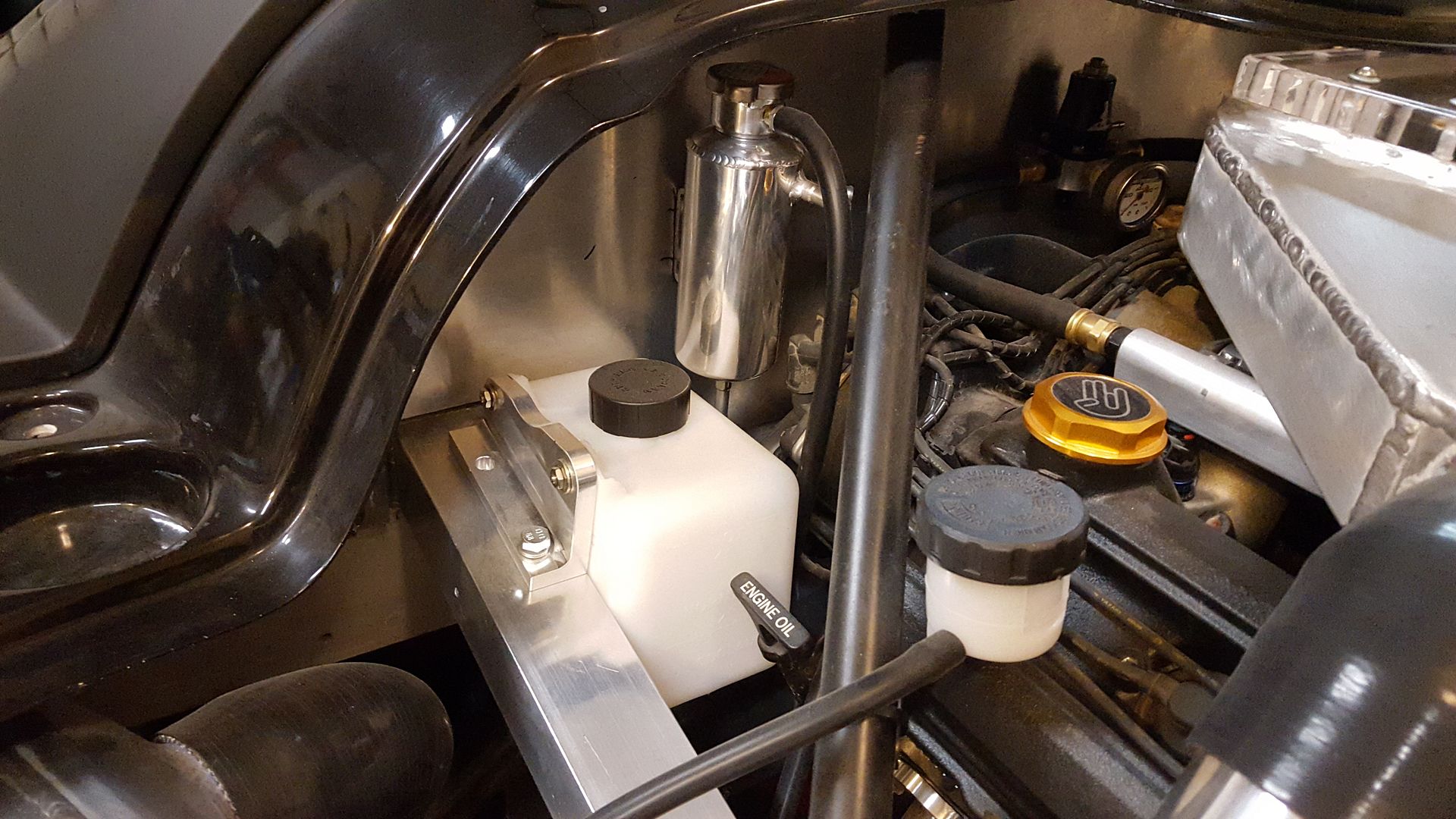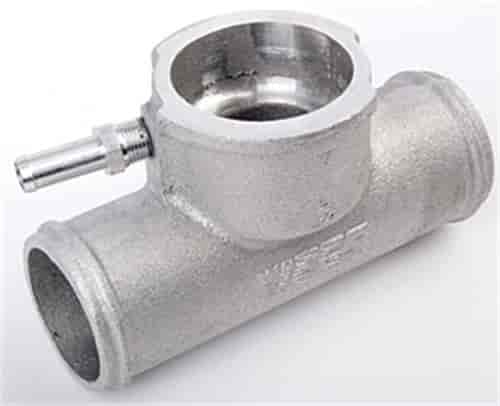- Forums
- GT40 Replica Manufacturers' Corner
- RCR Forum - RCR40/SLC/917/Superlite Aero
- The SLC Clubhouse
You are using an out of date browser. It may not display this or other websites correctly.
You should upgrade or use an alternative browser.
You should upgrade or use an alternative browser.
Coolant Tank
- Thread starter Dan carter
- Start date
i would just use the canton expansion tank - it's the perfect size/capacity/etc..
Canton Racing Coolant Expansion Fill Tanks 80-200 - Free Shipping on Orders Over $99 at Summit Racing
Canton Racing Coolant Expansion Fill Tanks 80-200 - Free Shipping on Orders Over $99 at Summit Racing
That's the tank I was looking at but wondered if mounted high on the firewall, can the filler be accessed or is the body in the way? Does it need standoffs to fit properly?
Colin
Colin
Ken Roberts
Supporter
It needs stand offs. I'm actually building a suitable bracket setup for it right now for my next project.
The few that have chosen to use it mount it lower and off to the drivers side. It has never been mounted to the firewall.
The few that have chosen to use it mount it lower and off to the drivers side. It has never been mounted to the firewall.
Hey Ken
Where would you attach it if not using the firewall?
Where would you attach it if not using the firewall?
Ken Roberts
Supporter
Got it; thanks
Pic of my set up, in mock up for spacing and height. A small header tank with pressure cap, that will overflow and burp into a vented overflow tank. Overflow tank can be lower than rest of system, but header tank must be higher.
I plan to cut body back to the ridge (about 1.5" back from where it is cut now) and/or cut a hole above the header tank for filling of system. A large rubber grommet can fill in hole when not needing to fill and finish off hole.

I plan to cut body back to the ridge (about 1.5" back from where it is cut now) and/or cut a hole above the header tank for filling of system. A large rubber grommet can fill in hole when not needing to fill and finish off hole.

IMO and experience the bottom of the tank should be higher than any other point in the coolant system. Otherwise the system will not self bleed air. I don't see how mounting that tank per the Stacy photo would work.
Has anyone put it there and have it self bleed?
I was wondering this as well looking at the picture - as long as the remote fill tank is the highest point of the system bleeding will be easy-peasy.
IMO and experience the bottom of the tank should be higher than any other point in the coolant system. Otherwise the system will not self bleed air. I don't see how mounting that tank per the Stacy photo would work.
Ditto.
Ken Roberts
Supporter
Here is a link to Pete's tank mount.
http://www.gt40s.com/forum/slc-clubhouse/42242-pete-bs-build-thread-7.html#post454019
http://www.gt40s.com/forum/slc-clubhouse/42242-pete-bs-build-thread-7.html#post454019
Am I confusing myself on this and let me say my experience.
I have an MR2 I race. Mid engine with the rad in the front. I have the rad cap in a high spot on rear. I fill it up and also have a valve on the top of the rad to bleed the air out so once all the air is out of rad I close it off and fill up the system. I have a rad cap on the engine that has a 20psi cap on it with a standard $10 pepboys overflow container that I ran up to the front to keep my weight up front as much as possible. I let the car get warm and it pushed out the excess water into the overflow container as needed and the air is pushed out of the line to the front container. Then when the engine cools down the water can be sucked back into the engine as needed.
Why all this talk of expansion tanks and other tanks and how high they need to be. I am confused as to the need and thoughts here and I am going to work on my cooling system next week.
I have an MR2 I race. Mid engine with the rad in the front. I have the rad cap in a high spot on rear. I fill it up and also have a valve on the top of the rad to bleed the air out so once all the air is out of rad I close it off and fill up the system. I have a rad cap on the engine that has a 20psi cap on it with a standard $10 pepboys overflow container that I ran up to the front to keep my weight up front as much as possible. I let the car get warm and it pushed out the excess water into the overflow container as needed and the air is pushed out of the line to the front container. Then when the engine cools down the water can be sucked back into the engine as needed.
Why all this talk of expansion tanks and other tanks and how high they need to be. I am confused as to the need and thoughts here and I am going to work on my cooling system next week.
Am I confusing myself on this and let me say my experience.
I have an MR2 I race. Mid engine with the rad in the front. I have the rad cap in a high spot on rear. I fill it up and also have a valve on the top of the rad to bleed the air out so once all the air is out of rad I close it off and fill up the system. I have a rad cap on the engine that has a 20psi cap on it with a standard $10 pepboys overflow container that I ran up to the front to keep my weight up front as much as possible. I let the car get warm and it pushed out the excess water into the overflow container as needed and the air is pushed out of the line to the front container. Then when the engine cools down the water can be sucked back into the engine as needed.
Why all this talk of expansion tanks and other tanks and how high they need to be. I am confused as to the need and thoughts here and I am going to work on my cooling system next week.
it sounds like your MR2 does that - your rad cap is the highest point in the system. Here the rad cap is part of the remote fill and you want that at the highest point in the system.
Good. I was not loosing my mind reading it. My rad cap is the highest point on my MR2 and the overflow is not pressurized and just hold the expanded coolant and it gets sucked in and out as needed.
So in reality we just need to have a rad cap in the highest location and a overlfow tank somewhere as that does not really matter. Maybe we are making it more complicated than it needs to be.

So in reality we just need to have a rad cap in the highest location and a overlfow tank somewhere as that does not really matter. Maybe we are making it more complicated than it needs to be.

Page 115 of the build manual shows a pressure tank and overflow tank. Looks like some builders have 1 tank some have 2......does the supplied tank do both jobs?
Page 115 of the build manual shows a pressure tank and overflow tank. Looks like some builders have 1 tank some have 2......does the supplied tank do both jobs?
The supplied tank has a relief valve under the pressure cap to run an overflow, but you have to provide that if you want one.
Most cars use an overflow, because without one the coolant that overflows is lost. With an overflow tank, it is allowed to be sucked back into the pressure tank as needed.
Here's a link to the wiki where the topic is discussed.
You will want an overflow. Most tracks would not let you run without one. Atleast at PIR here. Once you purge any coolant, that volume will be pulled back in and replaced with air without a proper overflow tank. It can be at any level, just make sure it is topped off half way, and the tube coming from the cap is fully at the BOTTOM of the tank. Like you would have a drinking straw. Overflow tank is atmosphere vented.
Plus it takes alot of serviceability out of it. No overflow, you must constantly pull cap to make sure system is full, otherwise, your temp gauge will tell you . With overflow, you only need to visually look at capacity in tank to know system is full.
Plus it takes alot of serviceability out of it. No overflow, you must constantly pull cap to make sure system is full, otherwise, your temp gauge will tell you . With overflow, you only need to visually look at capacity in tank to know system is full.
Ken Roberts
Supporter
The supplied tank has a relief valve under the pressure cap to run an overflow, but you have to provide that if you want on.
The supplied plastic Dorman tank does have a relief valve (under side of the cap) set at 16 psi but DOES NOT have any provision for a puke/overflow tank connection. It simply spits the coolant out and over the side of the tank.
It will definitely not pass tech at most drag strips and race tracks.
Similar threads
- Replies
- 0
- Views
- 182
- Replies
- 7
- Views
- 493
- Replies
- 8
- Views
- 385
- Replies
- 18
- Views
- 631
- Replies
- 0
- Views
- 170


